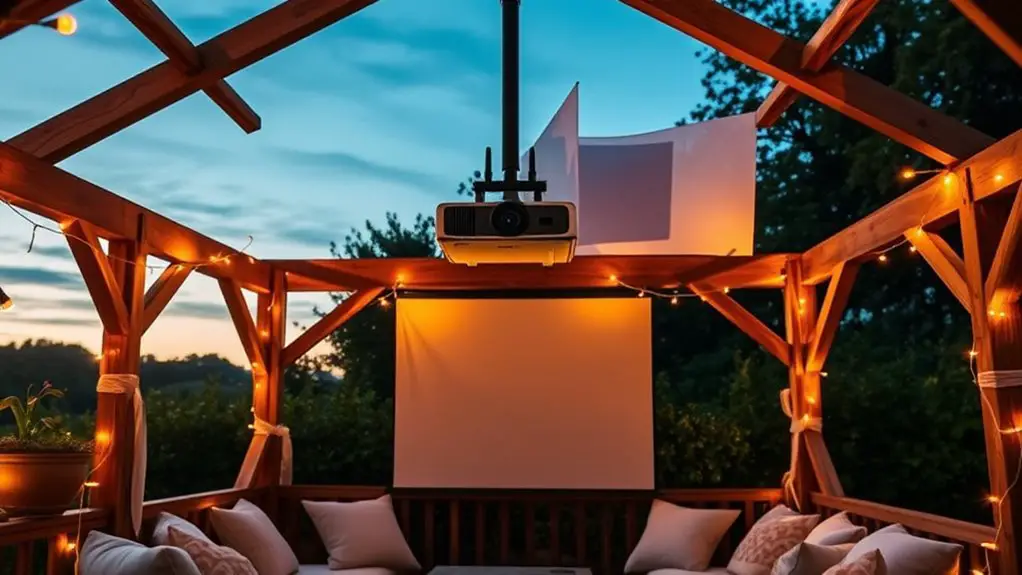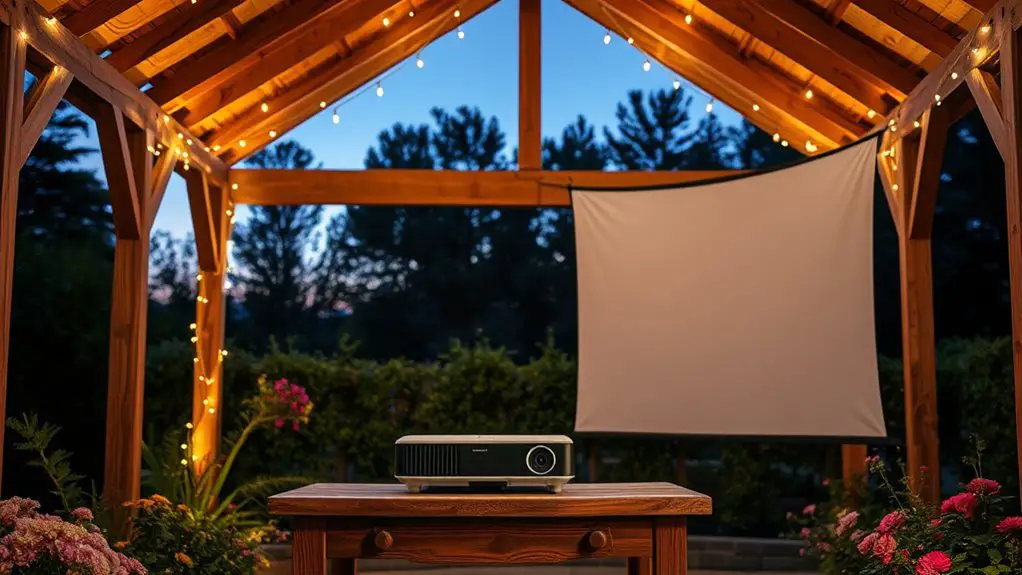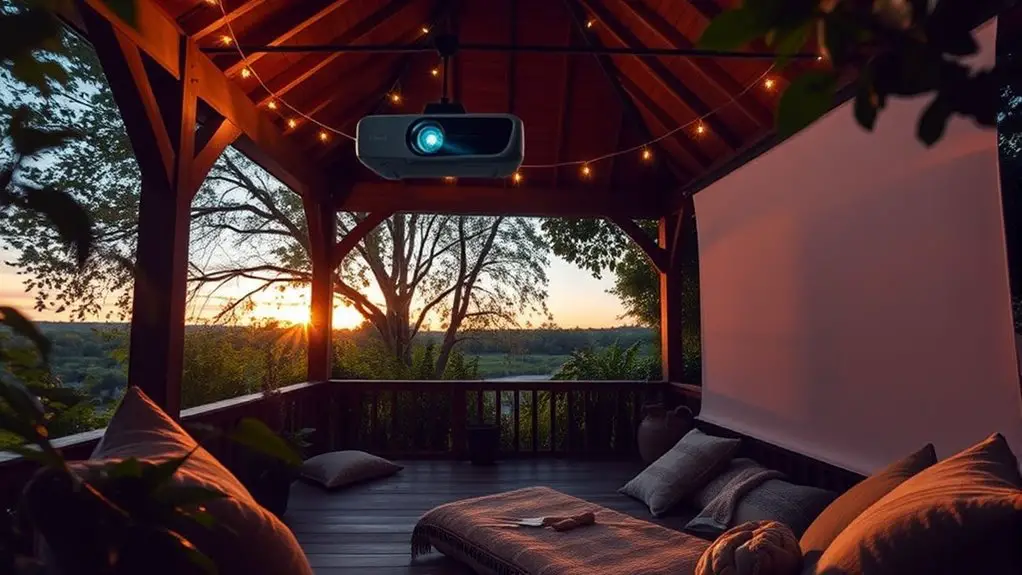To set up a projector and screen in your gazebo, start by selecting a projector with at least 2,500 lumens and a minimum resolution of 1080p. Choose a weather-resistant screen matched to your projector’s aspect ratio. Position the projector in a shaded area, ensuring a clear line of sight to the screen. Connect audio and video sources securely, managing ambient lighting for ideal image clarity. For additional insights on enhancing your setup, keep going!
Choosing the Right Projector for Your Gazebo

When selecting a projector for your gazebo, what factors should you consider to guarantee an ideal viewing experience? First, projector brightness is vital; you’ll want a model with at least 2,500 lumens to combat ambient light. If your gazebo is particularly bright, consider going higher. Next, examine the resolution options. A minimum of 1080p (full HD) is recommended for crisp, detailed images, especially if you’re showcasing movies or presentations. Higher resolutions like 4K provide even better clarity, but verify your source material supports it. Additionally, think about the throw distance to determine how far the projector needs to be from the screen. Portability may also matter depending on how often you’ll use your projector; lightweight models can be advantageous. By prioritizing brightness and resolution, you’re on the right path to creating a fascinating outdoor viewing environment that embraces your freedom to enjoy multimedia experiences.
Selecting an Appropriate Screen
When selecting an appropriate screen for your gazebo, consider the size of your projection area to guarantee ideal viewing. Different materials, such as vinyl or fabric, can greatly impact image quality and durability, so choose wisely based on your specific needs. Additionally, explore various mounting options to achieve a secure installation that complements your gazebo’s design. It’s also important to consider the weather-resistant materials used in your gazebo to ensure that your setup remains protected from the elements.
Screen Size Considerations
Selecting the right screen size is essential for maximizing your projector’s performance and ensuring an enjoyable viewing experience in your gazebo. You’ll want to take into account the screen aspect ratio, which should match your projector’s output for ideal image quality. Common ratios are 16:9 for widescreen formats and 4:3 for traditional presentations.
Next, determine your ideal viewing distance—this is typically 1.5 to 2.5 times the screen diagonal size. For instance, if you’re using a 100-inch screen, your seating should be 12.5 to 20.8 feet away. This distance helps maintain image clarity and allows for a comfortable viewing experience. By carefully selecting the screen size based on these factors, you can enhance your outdoor movie nights considerably.
Material Types Explained
Choosing the right screen material is just as important as determining the screen size for your projector setup in the gazebo. The effectiveness of your projection can vary greatly based on the screen materials you select. Matte white screens are ideal for environments with ambient light, reflecting colors accurately. If you’re looking for higher contrast, consider a gray screen, which can enhance black levels in darker settings. For outdoor setups, consider weather-resistant projector materials that can endure humidity and temperature fluctuations. Additionally, tensioned screens help eliminate wrinkles, providing a smooth surface for best viewing. By carefully selecting the appropriate screen materials, you’ll guarantee a picture-perfect experience that fully utilizes your projector’s capabilities while enjoying the freedom of outdoor entertainment.
Mounting Options Available
Although various mounting options exist for your projector screen, it’s vital to select one that suits your gazebo’s layout and your viewing preferences. Here are some common options to contemplate:
- Wall-Mounted Brackets: Ideal for flat surfaces, providing a secure hold.
- Ceiling Mounts: Perfect for maximizing space and reducing clutter; verify your ceiling can support the weight.
- Portable Stands: Offers flexibility to move the screen as needed; great for temporary setups.
- Motorized Screens: Convenient for automatic deployment and retraction; a sleek solution for a polished look.
Finding the Perfect Location
To achieve ideal projector performance, it’s essential to assess sunlight exposure in your gazebo. Position your setup where direct sunlight won’t wash out the image, ideally in a shaded area or during evening hours. Additionally, make sure the surface beneath the projector is level to maintain image clarity and prevent distortion.
Assess Sunlight Exposure
When setting up a projector in your gazebo, assessing sunlight exposure is essential to ensuring ideal viewing conditions. The sunlight intensity can considerably affect your projector’s performance and brightness. Here are four key factors to take into account:
- Time of Day: Observe how sunlight shifts throughout the day in your gazebo.
- Seasonal Changes: Different seasons bring varying sunlight angles and intensity.
- Surrounding Structures: Identify any trees, fences, or buildings that could cast shadows during your viewing times.
- Projector Brightness: Choose a projector with sufficient lumens to combat residual sunlight, ensuring images are clear and vibrant.
Ensure Level Surface
A stable foundation is essential for projecting high-quality images, so ensuring a level surface in your gazebo is a top priority. First, assess the ground beneath your gazebo; it should be level ground to enhance surface stability. Uneven surfaces can lead to distortion or misalignment of your projector’s image. If you find dips or raised areas, consider using leveling materials like gravel or paving stones to create a uniform base. Additionally, check that your projector is set on a sturdy platform to avoid vibrations that could affect performance. Finally, periodically reassess the surface, especially after heavy rains or settling, to maintain ideal conditions for your outdoor viewing experience.
Setting Up the Projector

Setting up the projector in your gazebo involves several critical steps to guarantee excellent performance and viewing experience. To achieve ideal projector placement, follow these guidelines:
- Determine the Distance: Calculate the distance from the projector to the screen. This guarantees the image fits perfectly without distortion.
- Choose the Right Height: Position the projector at an appropriate height, typically aligned with the top edge of the screen for a balanced display.
- Ensure Stability: Secure the projector on a stable surface or mount. This prevents vibrations that can affect image quality.
- Implement Cable Management: Organize your cables to avoid clutter and potential trip hazards. Use clips or tubing to keep everything tidy and secure.
Installing the Screen
After confirming your projector is properly set up, the next step is installing the screen. Start by selecting a suitable location within your gazebo that allows for ideal viewing. You’ll want to confirm the screen is mounted securely at a height that enables good projection alignment.
Here’s a quick reference table to guide you through the screen installation process:
| Step | Description |
|---|---|
| Choose Screen Type | Decide between manual, electric, or fixed. |
| Mounting Location | Confirm it’s flat and unobstructed. |
| Secure Installation | Use brackets or hooks to fix the screen. |
| Check Alignment | Test projection to confirm it’s centered. |
Once the screen is securely mounted, double-check the projection alignment. Adjust the position if necessary, and make sure there are no obstructions blocking the view. This will set the stage for an enjoyable viewing experience in your gazebo.
Connecting Audio and Video Sources

Connect your audio and video sources to secure a seamless viewing experience in your gazebo. This step is vital for confirming your setup functions smoothly. Here’s how you can achieve an ideal connection:
- Select the Right Audio Cables: Use high-quality audio cables to connect your projector to external speakers. This enhances sound clarity.
- Choose Compatible Video Adapters: Depending on your device, you may need HDMI, VGA, or other video adapters to connect your projector to laptops or streaming devices.
- Verify Connection Ports: Check both your projector and source device for the correct ports. It’s important to match cables and adapters appropriately.
- Test Your Setup: Before the main event, test your connections by playing a short video to confirm both audio and video are functioning correctly.
Creating the Ideal Viewing Atmosphere
To guarantee an enjoyable movie night in your gazebo, it’s crucial to create the right viewing atmosphere. Start by managing the ambient lighting; you’ll want it dim enough to enhance the projector’s image but not completely dark. Use soft, adjustable lights or lanterns that provide a warm glow, allowing for a cozy ambiance without overshadowing the screen. Additionally, consider incorporating energy-efficient lighting options to minimize electricity costs while maintaining the perfect mood.
Next, think about your seating arrangements. Opt for comfortable chairs or cushions that allow for easy viewing while accommodating your guests. Arrange the seating in a semi-circle facing the screen to make sure everyone has a clear line of sight. If you’re expecting a larger group, consider using blankets or outdoor rugs to create an inviting, laid-back space.
Finally, don’t forget to include some cozy throws or pillows to enhance comfort. With these elements in place, you’ll set the stage for a memorable movie experience under the stars.
Maintenance Tips for Your Setup
Creating a cozy atmosphere in your gazebo sets the stage for an enjoyable movie night, but maintaining that setup is equally important for ensuring a seamless experience. To keep your projector and screen in prime condition, follow these maintenance tips:
Creating a cozy gazebo atmosphere enhances movie nights, but proper maintenance is key for a seamless experience.
- Regular Cleaning: Use microfiber cloths and appropriate cleaning solutions to remove dust and fingerprints from the projector lens and screen. Avoid abrasive materials.
- Weather Protection: Invest in protective covers for your projector and screen when not in use. This helps shield them from rain, dust, and UV exposure.
- Check Connections: Periodically inspect cables and connections for wear or damage. Secure them to prevent accidental disconnection.
- Humidity Control: If you live in a humid area, consider using a dehumidifier in your gazebo to prevent moisture buildup, which can damage electronic components. Additionally, ensure that the gazebo is free from mould and mildew growth, as these can compromise the integrity of your setup.
Frequently Asked Questions
Can I Use My Projector During the Daytime?
Yes, you can use your projector during the daytime, but make certain it has sufficient brightness to combat ambient light. High-lumen projectors enhance daytime visibility, providing clearer images even in well-lit environments.
What Type of Extension Cords Are Safe for Outdoor Use?
For outdoor safety, use extension cords rated for outdoor use, typically marked “W” or “Weather Resistant.” Make certain they have appropriate cord ratings to handle your devices’ wattage, preventing overheating and enhancing longevity during outdoor events.
How Do I Protect My Equipment From Weather Damage?
Protecting your equipment from weather damage’s like shielding a knight in armor. Use durable equipment covers and consider weatherproof enclosures to safeguard against moisture, wind, and debris, ensuring your outdoor setup remains functional and pristine.
Is It Safe to Use a Generator for Power?
Using a generator can be safe if you verify it meets your power requirements and adheres to generator safety guidelines. Always maintain proper ventilation, avoid overloading, and keep the generator dry to prevent hazards.
Can I Watch Movies While It Rains?
Imagine cozying up on a rainy night, movie magic lighting your space. With proper waterproofing, you can definitely enjoy movie night in rainy weather. Just guarantee your equipment’s protected from moisture for a seamless cinematic experience.

